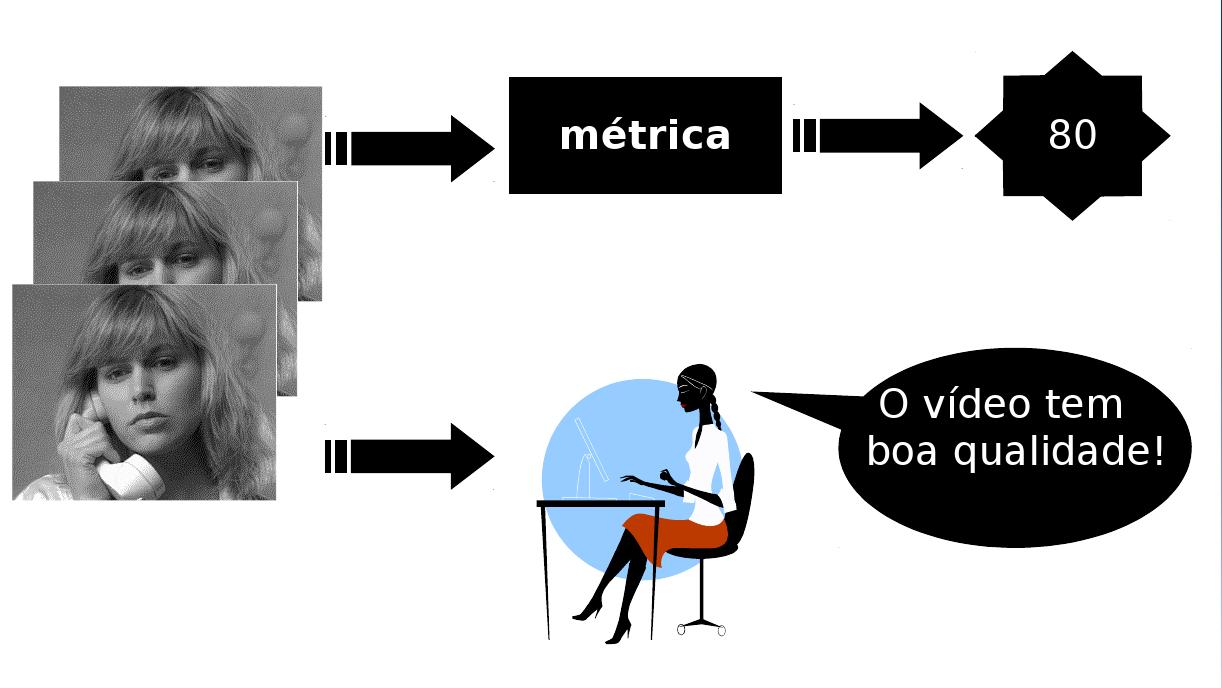Video quality metrics
Alexandre Fieno Silva
Pedro Garcia Freitas
Welington Yorihiko Lima Akamine
Alessandro R. Silva
Helard Becerra Martinez
Description
 |
Digital video communication has evolved into an important field in the past few years. There have been significant advances in compression and transmission techniques, which have made possible to deliver high quality video to the end user. In particular, the advent of new technologies has allowed the creation of many new telecommunication services (e.g., direct broadcast satellite, digital television, high definition TV, Internet video). In these services, the level of acceptability and popularity of a given multimedia application is clearly related to the reliability of the service and the quality of the content provided. As a consequence, efficient real-time quality monitoring schemes that can faithfully describe the video experience — as perceived by the end user — is key for the success of these and future services. |
The most accurate way to determine the quality of a video is by measuring it using psychophysical experiments with human subjects (subjective metrics). Unfortunately, these experiments are expensive, time-consuming and hard to incorporate into a design process or an automatic quality of service control. Therefore, the ability to measure audio and video quality accurately and efficiently, without using human observers, is highly desirable in practical applications. With this in mind, fast algorithms that give a physical measure (objective metrics) of the quality are needed to obtain an estimate of the quality of a video when being transmitted, received or displayed.
Quality metrics can be classified according to the amount of reference (original) information used: Full Reference (FR), Reduced Reference (RR), and No-Reference (NR) metrics. On the FR approach the entire reference is available at the measurement point. On the RR approach, only part of the reference is available through an auxiliary channel. In this case, the information available at the measurement point generally consists of a set of features extracted from the reference. Finally, on the NR approach the quality estimation is obtained only from the test video.
There is an ongoing effort to develop video quality metrics that are able to detect impairments and estimate their annoyance as perceived by human viewers. To date, most of the achievements have been in the development of FR video quality metrics. In particular, much remains to be done in the area of NR and RR quality metrics, which would certainly benefit from the incorporation of better perception models. In general, improvements can be achieved by incorporating better models for motion perception, pooling, and visual attention. A new trend in video quality design is the development of hybrid metrics, which are metrics that use a combination of the packet information, the bitstream header (without decoding), and the decoded video as inputs to the video quality estimation algorithm. With respect to applications, there is a great need for metrics that estimate the quality for multimedia applications. So far, very few metrics have addressed the issue of simultaneously measuring the quality of all media involved (e.g. video, audio, and text). Even for the simpler case of audio and video, there are only a few metrics in the literature that measure the quality of audio-visual content.
We believe that in order to design good quality metrics, it is necessary first to understand how video content is perceived. In this project, our goal is to design no-reference and reduced reference video quality metrics that are suitable for real time applications. Our approach consists of finding an overall quality model based on measurements of the most relevant features of the video. We aim to include perceptual models of the human visual system in the model, so that the results are better correlated with quality as perceived by human viewers.
Funding
Publications
Farias, Mylene C.Q.; MITRA, Sanjit Koumar . Perceptual Contributions of Blocky, Blurry, Noisy, and Ringing Synthetic Artifacts to Overall Annoyance. Journal of Electronic Imaging (Print), v. 21, p. 043013-043021, 2012.
Farias, Mylene C. Q.; Visual-quality estimation using objective metrics. Journal of the Society for Information Display, v. 19, p. 764, 2011.
FARIAS, Mylene Christine Queiroz; Carvalho, Marcelo M.; Kussaba, Hugo T. M.; Noronha, Bruno Henrique A.; Hybrid Metric for Digital Video Quality Assessment, In: 2011 IEEE International Symposium on Broadband Multimedia Systems and Broadcasting, 8-10 junho 2011, Erlangen, Alemanha.
Farias, Mylene Christine Queiroz. Video Quality Metrics. In: Floriano De Rango. (Org.). Digital Video. 1 ed. Vienna: INTECH, 2010, v. 1, p. 343-372
FARIAS, Mylene Christine Queiroz de . Video Quality Estimation Using Objective Metrics. In: Latin Display 2010, 2010, São Paulo.
Kussaba, Hugo T. M. ; FARIAS, Mylene Christine Queiroz. Blind Estimation of Blocking Artifacts in Digital Videos. In: Latin Display 2010, 2010, São Paulo.
FARIAS, Mylene C. Q.; MITRA, Sanjit K . No-Reference Video Quality Metric based on Artifact Measurements, IEEE International Conference on Image Processing, 2005, Genova. 2005. v. 3. p. 141-144.